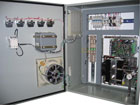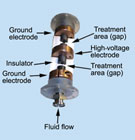Non-thermal processing techniques kill “bugs” quite effectively if they’re used correctly. But techniques like irradiation, pulsed electric field (PEF), high-pressure processing or pasteurization (HPP) and ozone are mostly unknown to consumers, and not always better understood by some processors.

Ozone is often created by a high-voltage corona. Here, ozone is created by plasma block technology combined with PLC control and touch screen interface operating the corona discharge above 20,000 hertz. Source: Guardian Manufacturing Inc.
Irradiating irradiation
The biggest problem with irradiation is the off-and-on-again nature of it. As Aaron Brody, PhD, president/CEO of Packaging/Brody Inc. (a consultancy in food packaging technology), says, “Radiation has been around since 1949 and has been up, down, around and around.” The FDA authorized radiation pasteurization for meats, and the US Army spent a lot of time perfecting it in the 1960s. NASA applied as much as 44 kGy min. radiation to sterilize frozen meats while the FDA recommended about one-tenth the levels for pathogen control. Consumers found over-irradiated, sterilized products didn’t taste good. But if applied properly, irradiation for pasteurization can be viable and doesn’t cause significant flavor issues.Unfortunately, the story doesn’t end so simply. One manufacturer, CFC Logistics, had planned a large meat irradiating plant near Quakertown, PA. Bad press in the local papers and just about everywhere else helped put an end to it as many Pennsylvanians were convinced another “Three-Mile Island” would be imminent. But more worrisome to consumers, as Brody points out, is that once the term, “irradiation” goes on the label, consumers are reluctant to buy the product inside-even if the meat is guaranteed free of nasty bugs.
Information from Idaho State University suggests irradiation doesn’t “sterilize” the food completely, killing all microorganisms; therefore, best practices still should be followed when handling and cooking irradiated food. While irradiation doesn’t cause food to become radioactive, it does cause some chemical changes in the food in the same way cooking does. While complaints have been leveled that the resultant chemicals produced by irradiation are carcinogenic, lately many cooked foods (especially starches) have been under scrutiny for acrylamide, a known carcinogen.
With all the bad press, it wasn’t surprising to find several vendors that were in the past involved in food irradiation have non-functioning Web pages or phone numbers. Some of those still in business said that food was no longer part of their services or a very small part of it.

Pulses are conducted through an electrode to a collar surrounding the tube through which the juice is flowing. Positive and negative pulse pairs of 1-10µs duration are applied to the juice in the gaps, destroying pathogens and harmful enzymes. Source: Diversified Technologies Inc.
PEF pulsing along
Pulsed electric field (PEF) technology has been through FDA approvals and was employed in 2005 at Genesis Juice in Eugene, OR. The processor wanted to preserve its organic commitment to customers and decided not to use thermal pasteurization, which would destroy most of its vitamin content and the healthful enzymes in raw juice. FDA officials put Genesis in contact with Ohio State University, which was developing PEF technology and licensed it to Diversified Technologies Inc. (Bedford, MA).PEF, says Mike Kempkes, Diversified Technologies VP of marketing, works well with juices, but could also be used for beer and wine. Yogurts and salad dressings have also been processed successfully with PEF in the lab. The requirement is that the media must be pumpable-liquid or slurry. Kempkes points out that while PEF is good at killing bacteria, it doesn’t kill spores. But spore formers don’t normally grow in acidified foods, which tend to be the products applicable to PEF.
According to Howard Zhang, research leader at ARS’s Eastern Regional Research Center (EERC) and previously on the Food Science faculty at Ohio State, PEF offers a 5-log reduction of most pathogens and is considered a pasteurized process, so product must be refrigerated. The advantage of PEF, he says, is to avoid the loss of flavor from normal thermal pasteurization.
PEF applies a strong electric field on a flowing fluid for a very short time. Above a critical field strength of about 15 kV/cm, vegetative cells are killed. Fields up to 35 kV/cm are practical today and can destroy bacteria, fungi and other microbes. Kempkes notes that since PEF can break down cell walls, another use for it may be the extraction of juice from plant materials such as sugar beets or grapes. Diversified Technologies, which provides the electronics for the system, has found PEF also works well in wastewater treatment. In either food or wastewater applications, volume is limited by piping size. The larger the piping, the bigger the electronics must be to sustain the output, which is not unlike a pulsed radar system. In the juice application, 10 microsecond pulses are applied in up to eight successive chambers as the juice passes by. With the short pulse duration, there is no heating effect.
But is PEF ready for primetime? “Yes, it is,” says Kempkes. This is a technology looking for users. But it’s not cheap. Figure about $1 million to get started, about the cost of high-pressure systems. While more than the cost of standard thermal pasteurization equipment, this system offers the advantage of continuous processing rather than batching.
As an epilog to the PEF story, in June, Toby’s Family Foods (Springfield, OR) acquired Genesis Juice with an eye toward increasing the product lines that Genesis carried. Sheldon Rubin, Toby’s Family Foods’ vice president, said its goals included keeping organic customers in mind by offering non-thermal pasteurization and expanding the variety of Genesis beverages even further. Toby’s Family Foods is also an organic supplier and has been using high-pressure processing techniques with a great deal of success. In expanding Genesis product offerings to include carrot juice, smoothies and other similar drinks, Toby’s found PEF couldn’t handle foaming beverages in a predictable way. Therefore, it has decided to process Genesis beverages using high-pressure pasteurization, and customers can soon expect to see their favorite label back on the shelf.

The life cycle of a bacteriophage that “eats” Listeria bacteria is shown above. At the end of the cycle, there is no longer a viable Listeria bacterium. Source: EBI Food Safety.
Squeezing germs
High-pressure literally squeezes bacteria to death while keeping intact food quality, taste and texture. With a typical HPP system, food products are packaged in a pouch or plastic bottle, then placed into a high-pressure vessel usually filled with water. The system is pressurized upwards of 80,000 psi or more for two to five minutes. Unfortunately, while HPP systems do a good job of killing microorganisms, they, too, are not as effective in killing spores; therefore, they can’t be used to process shelf-stable, low-acid foods. While HPP systems don’t affect the appearance of foods containing liquids, the pressure in these systems can crush foods with air pockets such as marshmallows or strawberries. Purdue has found for certain poultry products, it has been able to obtain a 2- to 6-log Listeria reduction, improve shelf life to 60 days and improve or extend fresh flavor.According to Zhang, the price of HPP may be a deterrent for all but large manufacturers. He estimates the cost at about five to 10 cents per pound. Glenn Hewson, Avure Technologies vice president of global marketing, says prices for an HPP system start around $650,000 and go up to $2 million or more. Because these systems work on a batch format, throughput can be an issue, although Hewson says that the larger systems are capable of processing more than 5,000 pounds of food per hour with a three-minute hold time.
Like PEF technology, what sells the higher cost of a non-thermal technology is the taste and appearance of the processed food, and most of all, the “clean label” that goes on the package. “As the world’s largest producer of high-pressure processed foods, we depend on our HPP systems to create the unique, clean-label products that our customers demand,” says Steve Parnell, president of Fresherized Foods. Parnell sees this technology as providing processors with space-efficient, higher-throughput systems to take advantage of the growing demand for fresher, natural and organic foods. Another company that has signed on to HPP is Portugal’s Frubaca Coopertiva, which uses HPP to produce all its natural fruit juices. Technical Director Jorge Periquito finds that a 5,000-lbs./hour unit will be sufficient to fill its production demands.
Hewson says it’s the clean label (“all natural-no preservatives”) that allows Hormel to introduce a new line of meats called Hormel’s Natural Choice. The line includes deli meats, carved chicken breast, dinner ham, bacon and Canadian bacon, and they’re all subjected to the 87,000 psi treatment. Hewson says when a processor considers removing what are perceived to be bad chemicals from a product, it can increase the cost customers are willing to pay, even though removing the chemicals saves a processor about two cents per pound. Today, the cost of HPP is about three cents per pound, a one-cent gain in cost. When customers see lunch meat contains only six ingredients (which are natural) instead of 12 (six of which are chemicals), they will pay a premium of 25 to 50% more. In addition, while an advertised shelf life of 60 days is twice the conventional 30 days, actual shelf life can extend to 90 days.

This chart shows the suppression of Listeria growth in smeared Muenster cheeses. Blue bars indicate cheese treated with bacteriophage; red bars indicate untreated cheese. Source: NIZO Research.
Gassing germs
Ozone was first used in the production of drinking water in the early 1900s in France and has been more generally used in Europe where it was found to be stronger than chlorine and much more effective over a wider variety of microorganisms. Ozone kills microorganisms through oxidation of their cell membranes, and most food-borne pathogens can be destroyed with ozone. Early uses in food processing include extending the shelf life of shellfish by five days through rinsing with ozonated water; using gaseous ozone to extend the shelf life of meats and eggs; and applying ozonated water to apples and other fruits to kill bacteria.In 2001, the FDA (21 CFR Part 173) approved the use of ozone in gaseous and aqueous phases as an antimicrobial agent for the treatment, storage and processing of foods. Ozone has multiple uses in food safety. Guardian Manufacturing Inc. is a controls and automation system integrator with experience in using ozone. According to Jim Baker, Guardian Manufacturing Inc. national accounts manager, ozone is a good match for direct contact of all meat, poultry, fruit and vegetables, plus bottled water. For clean-up operations, ozone can be applied to all surfaces in the food processing environment, used in CIP systems and applied in many applications during the production operation.
John McClain of McClain Ozone services 2,000 wineries in California as well as Coca-Cola and Coors. But he’s also working with producers of mushrooms, bean sprouts, fish and produce that use ozone at one or more phases of the process. While ozone can kill bacteria 3,000 times faster than chlorine, it doesn’t leave the toxic byproducts related to chlorination. Ozone is also 51% more effective on bacterial walls than chlorine and can control and remove films that build up on processing equipment.
Proper application of ozone can knock down Salmonella by 6 log (99.9999%), Escherichia coli by 5 log (99.999%) and Lysteria by 4 log (99.99%). Some researchers, however, have found 0.5% ozonated water may only have an effect of 1.3 to 2.5 log when used on beef tissue. According to Mark Taggatz, president and owner of Ozone Safe Food, proper application levels vary according to temperature, water composition and food product composition. Proper application depends on careful engineering and planning to determine prescribed dosage, contact time and application, so there isn’t a one-size-fits-all approach. A basic rule of thumb is that for water-based contact, a level of 1.0 ppm will be sufficient for many applications, and for water-based clean-up, a level of 2.0 ppm should be sufficient.

The “treated by irradiation” logo goes on all food that is exposed to radiation. Source: FDA.
Eat my bacteria!
Listeria monocytogenes (Lm) wreaked havoc in turkey luncheon meat about five years ago as the FDA traced the bacteria to a Wampler plant in Franconia, PA. Seven deaths in the northeastern US were attributed to the bacteria, plus dozens of people were sickened. Lm bacteria also contaminate cheese and ready-to-eat foods such as hot dogs, sausages and other deli-style foods, and they thrive and multiply in the refrigerator. A year ago, the FDA first approved the use of bacteriophages as a food additive to kill Lm bacteria, and this ruling has had suppliers worldwide scrambling to get their products approved.According to the FDA, bacteriophages (phages) are viruses that infect only bacteria and do not infect mammalian or plant cells. (See related story on page 167 in this issue.) In fact, phages are nature’s own device to control bacteria. Phages are ubiquitous in the environment, and humans are routinely exposed to them at high levels through food and water without adverse effect. Phages are very specific. They infect and destroy only the targeted host organism, as a result of which, the final product does not contain any viable Listeria.
Bacteriophages, according to Mark Offerhaus, CEO of EBI Food Safety (Netherlands), provide a safe, non-chemical solution to ridding RTE foods of Lm. EBI’s product, LISTEX, already in use in Europe, was approved “GRAS” (generally recognized as safe) by the FDA the first week of July for use in all food products in the US. As confirmed by the USDA/Food Safety Inspection Service (FSIS), LISTEX has no adverse effect on organoleptic properties (color, odor and taste). A culture of bacteriophages, such as LISTEX, can be diluted in a solution and applied to the food surface by dipping, spraying or showering. The best point of application is generally the closest to the point of expected contamination. Bacteriophages can function in temperatures from 1 to 35°C (34 to 95°F), survive in saturated NaCl solutions, are not affected by atmosphere, work in solutions with a pH range of 5.5 to 9.5 (7.7 is optimum) and are inactivated by temperatures in excess of 50

